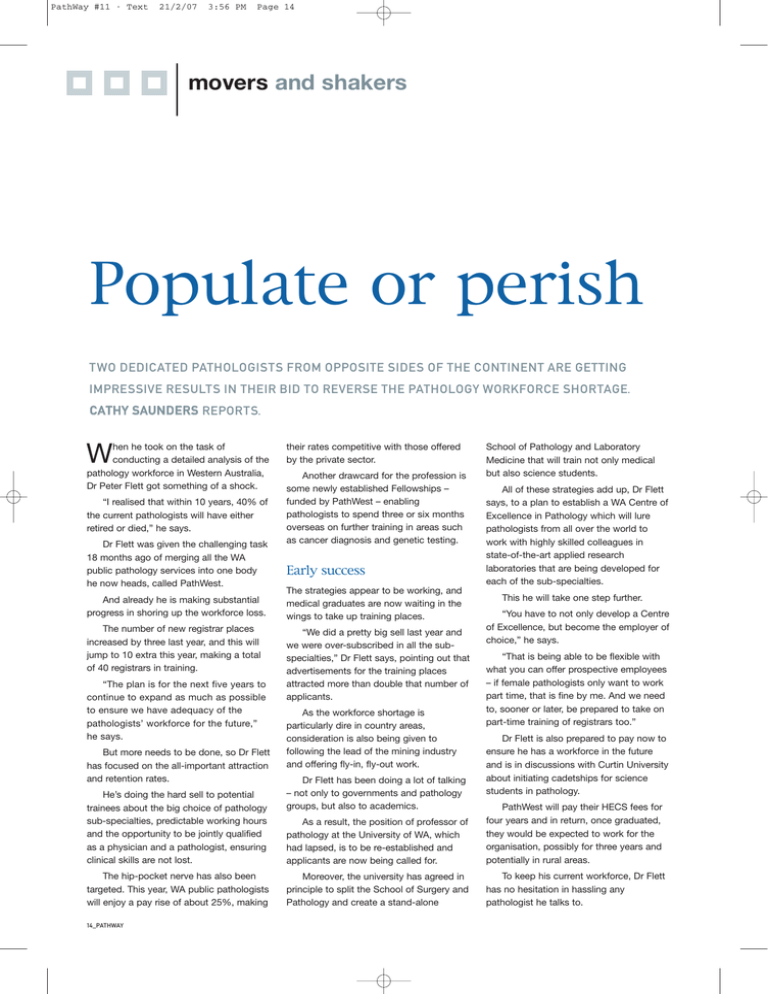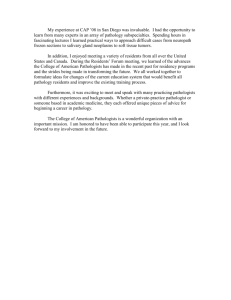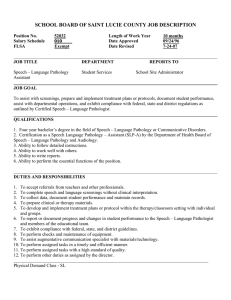W
advertisement

PathWay #11 - Text 21/2/07 3:56 PM Page 14 movers and shakers Populate or perish TWO DEDICATED PATHOLOGISTS FROM OPPOSITE SIDES OF THE CONTINENT ARE GETTING IMPRESSIVE RESULTS IN THEIR BID TO REVERSE THE PATHOLOGY WORKFORCE SHORTAGE. CATHY SAUNDERS REPORTS. hen he took on the task of conducting a detailed analysis of the pathology workforce in Western Australia, Dr Peter Flett got something of a shock. W “I realised that within 10 years, 40% of the current pathologists will have either retired or died,” he says. Dr Flett was given the challenging task 18 months ago of merging all the WA public pathology services into one body he now heads, called PathWest. And already he is making substantial progress in shoring up the workforce loss. The number of new registrar places increased by three last year, and this will jump to 10 extra this year, making a total of 40 registrars in training. “The plan is for the next five years to continue to expand as much as possible to ensure we have adequacy of the pathologists’ workforce for the future,” he says. But more needs to be done, so Dr Flett has focused on the all-important attraction and retention rates. their rates competitive with those offered by the private sector. Another drawcard for the profession is some newly established Fellowships – funded by PathWest – enabling pathologists to spend three or six months overseas on further training in areas such as cancer diagnosis and genetic testing. Early success The strategies appear to be working, and medical graduates are now waiting in the wings to take up training places. “We did a pretty big sell last year and we were over-subscribed in all the subspecialties,” Dr Flett says, pointing out that advertisements for the training places attracted more than double that number of applicants. As the workforce shortage is particularly dire in country areas, consideration is also being given to following the lead of the mining industry and offering fly-in, fly-out work. Dr Flett has been doing a lot of talking – not only to governments and pathology groups, but also to academics. School of Pathology and Laboratory Medicine that will train not only medical but also science students. All of these strategies add up, Dr Flett says, to a plan to establish a WA Centre of Excellence in Pathology which will lure pathologists from all over the world to work with highly skilled colleagues in state-of-the-art applied research laboratories that are being developed for each of the sub-specialties. This he will take one step further. “You have to not only develop a Centre of Excellence, but become the employer of choice,” he says. “That is being able to be flexible with what you can offer prospective employees – if female pathologists only want to work part time, that is fine by me. And we need to, sooner or later, be prepared to take on part-time training of registrars too.” Dr Flett is also prepared to pay now to ensure he has a workforce in the future and is in discussions with Curtin University about initiating cadetships for science students in pathology. He’s doing the hard sell to potential trainees about the big choice of pathology sub-specialties, predictable working hours and the opportunity to be jointly qualified as a physician and a pathologist, ensuring clinical skills are not lost. As a result, the position of professor of pathology at the University of WA, which had lapsed, is to be re-established and applicants are now being called for. PathWest will pay their HECS fees for four years and in return, once graduated, they would be expected to work for the organisation, possibly for three years and potentially in rural areas. The hip-pocket nerve has also been targeted. This year, WA public pathologists will enjoy a pay rise of about 25%, making Moreover, the university has agreed in principle to split the School of Surgery and Pathology and create a stand-alone To keep his current workforce, Dr Flett has no hesitation in hassling any pathologist he talks to. 14_PATHWAY PathWay #11 - Text 21/2/07 3:56 PM Page 15 “You have to not only develop a Centre of Excellence, but become the employer of PHOTO CREDIT: TONY MCDONOUGH choice.” - Dr Peter Flett “The message I say to everybody – all the clinicians – is ‘you can’t retire, you have to keep working’,” adding that he is happy to be very flexible with their work conditions. “The point about all this is we haven’t got much time. If we sit on our hands we are going to be caught. The clock is ticking on this one. “I think it is up to us in each of the states to be far more vocal than we have been in pathology and take it to the feet of the ministers who matter and make them realise that if they don’t do something, they won’t have a pathology service in 10 years time.” WA Minister for Health Jim McGinty says the WA Government sees the provision of pathology services as a priority and is confident that the government-funded health reform initiatives – which include the strategies to attract, train and retain pathologists – will significantly impact on the pathology workforce. Meanwhile, back in Qld… On the other side of the country, University of Queensland pathology professor Sunil Lakhani is working to ‘hardwire’ the relationships between the university’s pathology department, the Queensland Institute of Medical Research (QIMR) and the statewide Queensland Health Pathology Service (QHPS), which are independent but which he believes can help each other on various levels. Professor Lakhani arrived in Brisbane in late 2004 to head the university’s academic department. He and his research group – now based at the QIMR – came from the UK to new horizons in Australia. His clinical work as a breast cancer pathologist for QHPS at the Royal Brisbane and Women’s Hospital means he has “a foot in each place”. The first task was to build up the university department. “The academic department was pretty much down to one senior person when I came,” he says. “It had been struggling – as have all academic departments around the world – chiefly due to an inability to recruit staff. This is due to a shortage of trained academics with a strong research background and the huge differential in income, which has fallen way behind compared to that of clinical pathologists. “Until the government addresses these issues, it will continue to be so.” PATHWAY_15 > 21/2/07 3:56 PM Page 16 PHOTO CREDIT: GIULIO SAGGIN PathWay #11 - Text “What is needed are good role models, people who are good diagnostic pathologists and also good researchers.” - Professor Sunil Lakhani Talks are underway with the Queensland state government to improve academic pay rates, but at present the problems of recruitment continue. Nevertheless, Professor Lakhani is pushing on in rebuilding the department. A French pathologist has been appointed senior lecturer, an associate professor who is a non-clinical researcher heads a laboratory, and there is funding for another senior lecturer or associate professor who is yet to be appointed. Recently, Professor Lakhani gained extra funding from the university for an academic pathology registrar who is teaching and conducting research in the university department as well as doing hospital clinical work. “This position forms part of the [pathology] training rotations through the hospitals and the university, in order to further the links between academic and clinical departments and to encourage other trainees who are in the full-time diagnostic training to rotate into the academic department,” he says. Each year, a new registrar will be offered this position. “This means that we will slowly expose the whole pool of registrars to academic activities in the hope that we can demonstrate the role of academic work to our trainees and also rebuild the academic infrastructure in Queensland.” Another academic registrar, funded by the Ludwig Institute for Cancer Research, has been lured from Brazil on a Fellowship to do his PhD in Professor Lakhani’s research laboratory. It is hoped that his lifestyle of clinical activity, research, writing papers and presenting at international conferences will help to change the ethos and be a role model for local registrars. 16_PATHWAY Professor Lakhani has also established a link with a medical education unit in the School of Medicine so that new clinical registrars who participate in teaching medical students learn strategies for teaching and assessing the students. “This will not only provide valuable skills to registrars, but will further enhance the links between clinical and academic work,” he says. A further line of attack has been made possible by his role of running a research laboratory at the QIMR, which is located on the same campus as the medical school and the Royal Brisbane and Women’s Hospital. “Having a research laboratory on the campus means we can get registrars and other interested colleagues to come and have a look at how it is possible to do good clinical work and bring questions into the research laboratory, in the hope that answers can be translated into clinical management of patients,” he says. “What I am trying to do is to hardwire relationships between these three organisations – teaching, research and clinical work.” While building up academia, Professor Lakhani has also been working as a specialist breast pathologist with QHPS, where similar expansion and recruitment has also happened. There are only a couple of vacancies for pathologists in the metropolitan area, and these are for newly funded specialist positions. Negotiations to fill the only regional position are underway. Moreover, according to a spokesman for QHPS, two new registrar training positions were approved from last July and eight were approved from January. All but one have been filled. Six positions had also previously been approved in 2005. For the first time, three of the positions are for general pathologists who, it is hoped, will end up working in regional centres, which are always harder to staff. The QHPS has chalked up further success. All but one of last year’s graduates have opted to stay in the public system, lured largely by a new package of improved conditions introduced in January last year, which include a 7% pay rise and higher on-call and private practice allowance rates. Professor Lakhani says he is getting good feedback from registrars who are slowly being exposed to the rewards of teaching and research in pathology. “What is needed are good role models, people who are good diagnostic pathologists and also good researchers,” he says. “When they see how research affects diagnostic practice and clinical management, they are able to grasp the central role that pathology plays in science and medicine.”



